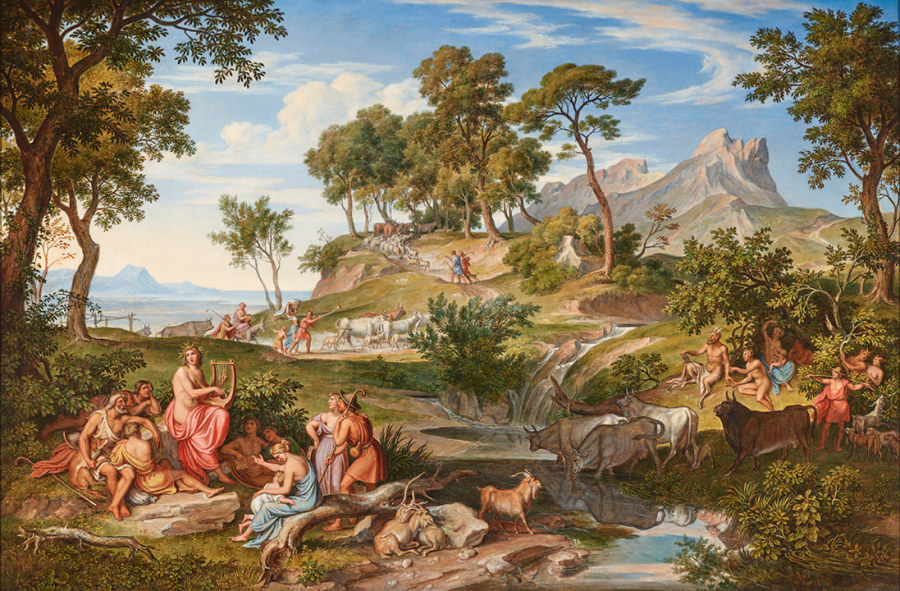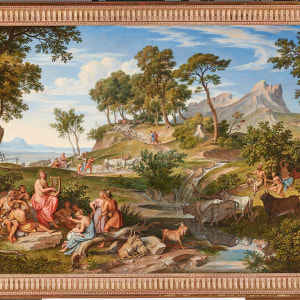Provenance
Private collection, England
Private collection Switzerland, 1852
Sale, Grisebach, Berlin, 28 May 2014, lot 109
Private collection, California (acquired at the above sale)Exhibited
Los Angeles, J. Paul Getty Museum, Zeitgeist, Art from Germanic World 1800-1900, 10 February- 17 May 2015, no. 32
Literature
Otto R. von Lutterotti, Joseph Anton Koch, 1768-1839. Mit Werkverzeichnis und Briefen des Künstlers, Berlin, Deutscher Verein für Kunstwissenschaft, 1940, no. G 122, p. 229
Otto R. von Lutterotti, Joseph Anton Koch, 1768-1839. Leben und Werk. Mit einem vollständigen Werkverzeichnis, Wien und München, Herold Verlag, 1985, no. G 90a, p.305, ill. no. 66, p.186
Catalogue note
1832 was a good year for Joseph Anton Koch (1768-1839). Late that year he had received a commission for seven historical-mythological scenes from Hermann Härtel (1803-1875), heir to the important music publishing house Breitkopf & Härtel in Leipzig. They were intended for Härtel’s “Roman Villa,” a kind of contemporary Villa Farnesina that he had constructed in the heart of his hometown between 1832 and 1834. Free to choose his subject matter, Koch picked themes conducive to his interest in landscape: Apollo among the Shepherds, the Abduction of Hylas, Diana and Actaeon, Silenus and His Followers, the Death of Orpheus, Nessus’s Rape of Deianira, and Chiron Teaching Achilles to Play the Lyre. Unfortunately, the fresco project never progressed beyond its initial stage, and Koch decided to execute his design in oil instead. In 1833/34, he finished the first version of Apollo among the Shepherds. It was an immediate success. Peter Cornelius (1783-1867), one of the most celebrated figureheads of the Nazarene movement and by then director of the influential Munich Academy of the Fine Arts, even considered it among Koch’s best works.
The scene unites two separate episodes of the Apollo myth, linked by their mutual emphasis on music and cultivation. On the left we see Apollo, here still a soft and beautiful youth, tending to the herds of King Admetos, the ruler of Pherae in Thessaly. On the other side, we find a satyr who is about to challenge the Olympian to a musical contest (or maybe, this has already happened?). Be this as it may, Apollo’s servitude to a mortal master was the punishment inflicted upon him by his father, the mighty Zeus, for having killed the Cyclopes, the makers of his thunderbolts. Admetos, however, treated the young God well; Apollo repaid the king’s kindness manifold, not least by helping him to win his chosen bride, Alcestis, and making all the king’s cows have twins. In this scene, however, Apollo is shown as the harbinger of education, peace and prosperity. Even the ever so rowdy he-goats at the river bed have been appeased by the sweet sound of his lyre. On the other side of the brook, a group of satyrs and their entourage look over and, equally mesmerized, put down their own instruments in a gesture of defeat. The most prominent of them, goat-legged, with horns and a rugged face is Pan, as Koch himself suggested in a brief aside to the Danish sculptor Bertel Thorvaldsen, who acquired the composition’s first version when the paint was hardly dry. But most have seen in the figure another of Apollo’s unfortunate challenger, the satyr Marsyas, who had taught himself how to play the traditional aulos, that double flute he had found discarded by its divine inventor, Athena. Is he, we might wonder, the other satyr, pointing toward the divine musician on the other side of the brook? Be that as it may, both satyrs stare at the God with undisguised admiration. Or do they?
The composition has often been interpreted in this way, with Apollo shown as the unquestioned victor of a musical challenge. After all, everyone is looking in his direction, and even we, the viewer, are first drawn to his presence. “In making music, they both represent art, but the satyr Marsyas … represents the instinctive, the wild, the unconventional, whereas Apollo stands for the more rational, the balanced, the idealizing. It is typical of the neo-classical Koch,” Christian von Holst observes, “that he should focus on a mythological scene in which reason wins over emotion, but in such a way that the contrast between the two does not affect the fundamental harmony of the Arcadian landscape.” This is one possible reading; yet it seems equally likely that we witness the moment just before Pan or Marsyas (or both?), is reckless enough to challenge the immortal opponent. Apollo agreed, but only under the condition that the victor could do as he wished with the loser. In Marsyas’s case, this would lead to sadistic bloodshed. Winning by trickery, the God brutally murdered his rival, suspending Marsyas from a pine-tree and then flaying him alive. The memory of this vicious act lurks beneath the landscape’s serene surface, especially for those contemporary viewers familiar, like the artist,with Karl Philipp Moritz’s influential Götterlehre of 1790. Those viewers, then and now, sense a powerful element of anti-aesthetic sublimity in Koch’s composition: Marsyas emerges as the modern artist’s alter ego, a potent reminder that his flagrant corporeality, like our entanglement in the material, can no longer be sublimated. This seems a quite apt reading for Koch’s programmatic juxtaposition of the Apollinian and the Dionysian.
Regardless of the staffage’s interpretation, the landscape itself is of unalloyed beauty. Koch centered the scenery on La Serpentara, a small forest of holm oaks above the Italian town of Olevano. The spot, which offers an impressive view over the hilly landscape, had been Koch’s artistic discovery, and its picturesque interplay of vegetation, rocks and light would attract poets and artists throughout the 19th century. When the grove was to be cut down in 1873, it was not surprising indeed that another German artist, Edmund Friedrich Kanoldt (1845-1904), launched a successful fundraising campaign for its preservation. But Koch himself was interested in more than merely depicting some enchanting vedute. He played freely with the elements gleaned from his intense studies of the Campagna Romana and the Alban hills, forging from them “his own melody of language and image.” The result was a symphony of colors structured by an exceedingly skilled draftsmanship, whose ultimate sentiment, however, went beyond a quest for formal beauty. A deeply progressive thinker, his association with this particular geography, like with the Alps before, were as emphatically personal as they were profoundly political. Melodic yet erudite, emotional yet rational, the scenery ultimately reveals itself as a testimony to Koch’s revolutionary ideals, to his never-ending advocacy for personal freedom and human self-fulfillment.




